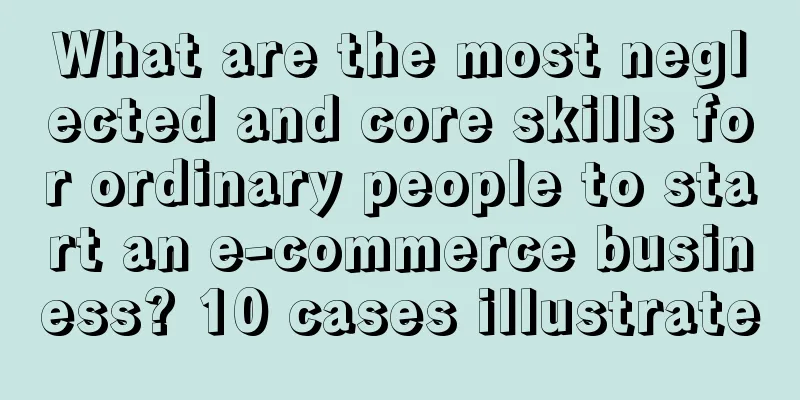What are the most neglected and core skills for ordinary people to start an e-commerce business? 10 cases illustrate

In my previous article, I mentioned that when ordinary people start to start a business, they should start from the order of trade, industry and technology. After I finished writing the article, many readers gave me feedback: I do know that in the early stages of starting a business, you should not start with research and development, but start with trade first. The "trade" here means purchasing goods from existing supply channels in the market, such as 1688, Yiwu Small Commodity City, offline wholesale markets, stall markets, factories, etc., and then reselling them. Run through the entire process, generate sales and traffic. But readers also reported another problem: I buy goods from the market, and so do others. So aren't the goods we sell the same? Where is my competitiveness? Once others' prices are lower than mine, customers will find that the goods are the same but the prices are lower, so won't they all go elsewhere to buy? To sum up the problem, how can we differentiate ourselves and become competitive when we sell market currency in the early stage of starting a business? This problem is actually the most easily overlooked problem for many ordinary people in the early stages of e-commerce entrepreneurship. Because everyone may have watched some e-commerce courses. These courses are all about how to open a store, how to move products and pictures from 1688, how to let suppliers drop ship, how to brush orders, how to promote, and how to look at data, but they do not talk about how to package the products. The products you sell are very common, the pictures are very crude, there is no recognition, and they are very homogeneous. How can you sell them? How can you promote them through advertising? How do you compete with others when everyone is selling the same product with the same pictures? So this involves one of the most important core skills in e-commerce entrepreneurship: secondary marketing packaging of market currency. Through various low-cost marketing packaging methods, the market currency in your hands can become completely different and even more attractive, thereby creating differentiated sales competition. Otherwise, it is completely meaningless to sell the same products as others and focus on fake orders, advertisements, and traffic every day. Because other people’s products are the same as yours, or even cheaper and have higher sales than yours, how can you outsell them? So how to package the market currency for marketing, and from which levels can we start? I will explain in detail with multiple cases below. 1. Visual levelVision is the most important part of currency packaging, because in shelf e-commerce, what you sell is not the product, but the picture. Let me emphasize again that when doing shelf e-commerce, what you sell is not products, but pictures. Therefore, by reshooting and redesigning the products at the visual level, especially the shooting level, you can quickly differentiate and make your products stand out. Of course, the cost, means, and difficulty of redoing the visuals of each category are also different. Let’s take accessories as an example. We open 1688 and see a recently popular Roman double ring necklace, which costs around 6 to 9 yuan. As you can see, this best-selling model is very popular on 1688, so it should be even more popular on Taobao or Douyin. Since everyone is selling this product and they are all selling the same style, we must first create differentiation and recognition through picture taking. For example, some merchants, after receiving the necklace, will use this close-up display of the necklace on the hand to take a different style of product display picture. This is the simplest form of differentiation. Some merchants will wear it directly on the body and create a personalized main picture visual through cropped shots. You don’t need to show your face, just your collarbone, and wear the product to complete the personalized picture vision. This display method is mainly used in the jewelry category Some businesses achieve visual differentiation by placing the product in still life and re-photographing it. I have always believed that accessories are a category that is very easy to complete visual secondary packaging. It is also a category that is very suitable for female friends to start a business. Because the product is relatively small, the price is low, and the face does not need to be shown, the requirements for light and shadow and background are not very high. As long as you master some shooting skills and use the partial performance of your own body, you can achieve product visual differentiation. Many girls who work in accessories don’t need to show their faces at all. They can complete the visual shooting of the product by wearing it on their collarbones, necks, and ears. And they can also take very high-end photos. The following are some examples of secondary packaging photography of some accessories. In addition to accessories, let’s take another daily life category as an example, such as thermos. If you want to sell thermos, you can also create a differentiated visual. For example, this thermos cup from 1688 is priced at 18.8 yuan. It can be seen that it is a hot-selling model with sales of more than 60,000. I have to say that the quality of the pictures from this supplier is quite high, and it is indeed difficult to create secondary works. However, each business still tries to create different visual styles through different shooting and photo-editing methods. For example, some businesses borrowed the shooting ideas of the original picture, made fine adjustments, re-photographed, enhanced the sense of light and shadow, changed the order of placement, and obtained a new product. Some merchants also thought that the original pictures were too cluttered, so they streamlined them to get more focused product pictures. Some businesses think that the original image is hard to surpass, so it is better to go for a simple route to appear unique... Another example is the product of children's schoolbags. This children's backpack from 1688 is priced at 18.8 yuan, and the entire product visual has a pure white background. After receiving this product, merchants from Pinduoduo and Taobao redesigned the visuals, some re-Photoshopped the background, some used child models for reshoots, and some used creative expressions. Although the overall visual quality was average, it was differentiated from the original product. From the above examples, we can see that through different visual transformations, the tonal transformation of the product can be initially completed. The better the visual effect, the greater the sense of uniqueness it gives to consumers. Moreover, the most important point of redoing the visuals is to increase the premium. Good pictures will make the product appear more advanced, and more advanced products will naturally get higher prices, and have more potential to drive consumers to buy. It’s like selling Sichuan peppercorns. Sichuan peppercorns themselves are not unique, but different visual presentations can give the product a different tone. 2. Group levelAfter selling things for a long time, everyone will talk about pallets and grouping goods. Different product combinations will allow your products to face different consumer groups, thus creating product uniqueness. For example, let's take the mobile phone case category. This is a category with extremely high volume, fierce competition, and a very low threshold. However, through different product grouping methods, a unique product lineup can still be created. For example, a mobile phone case flagship store, hereinafter referred to as Store A , focuses on the Disney cartoon mobile phone case series, with large sales. Everyone can feel the strong cartoon style, cute style, anime style, and two-dimensional style of the store. Its consumer group is not mainly male, but basically female, and they are the kind of little girls who like cartoons. We selected one of the products as a reference and chose the little princess phone case from this store. This mobile phone case is also sold by a competing store, which we call Store B , and it also sells very well. You can also see that among the products in store B, the best-selling ones are basic or creative mobile phone cases. Therefore, the group of people that store B faces is the general consumer group. Of course, the general consumer group will inevitably include people who like the Little Princess cartoon phone cases, but the main products sold are still those basic phone cases and general creative phone cases. Then through different groups of goods, after long-term operation:
By grouping their products differently, Store A and Store B target different consumer groups, resulting in them not fearing competition even though some of their styles overlap.
The most common category in which products are created through grouping is clothing. In a sense, the clothing category is all about the art of grouping. For example, let’s take the [Casual Wide-Leg Pants] from 1688. This pair of pants is now hot-selling on the entire network, and many merchants will directly sell them using the original picture. But under different grouping styles, the pants present different positioning along with the grouping. For example, in this [Hong Kong style store], this style is combined with other trousers and tops to create a Hong Kong style product combination (but this Hong Kong style is indeed a bit cheap) In another store, this style joins many other styles to create a casual and cute little girl style; Although they are the same pants, they represent different styles in different stores and attract different groups of people. This is just the apparent group of goods. This pair of pants may be re-photographed and re-matched to create styles such as internet celebrity style, commuter style, casual style, European and American street style, etc., but due to time constraints, we will not delve into it here. This pair of pants was re-photographed and became a hit in a certain online celebrity store, creating a new Korean girl style. Since it is an e-commerce business, a store sells dozens or even hundreds of products. If these products can be used to create an extremely unified style, it doesn’t matter whether everyone is selling the same thing. Because the extremely unified style will help you carve out the group of people that suits you. 3. Product details page levelThe product detail page is also the best way to differentiate your product from other similar products. The more detailed the product details page is, the more selling points it contains, and the more exquisite it is, the more it proves that your product is genuine and high-quality. Because only products without any quality assurance or counterfeit products would have such sloppy detail pages. For example, we chose the car phone holder product. Because this product is highly homogenized, there is not much differentiation in terms of function and aesthetics. Therefore, whoever can make the product details page advanced and exquisite will have a great impact on sales and conversion. We select part of the product details page with the highest sales volume. In addition to the exquisite page, it displays more than 20 selling points and more than a dozen parameters. We then select the product details page of similar products with poor sales, and you can clearly feel that the entire design is full of a strong sense of copycat. The prices of these two products are actually similar. If a customer compares the two products, he will definitely buy the one with a more beautiful product details page. Let’s take a popular women’s shoe as an example. This pair of casual flat shoes is a hot item at the moment, with more than 10,000 pairs sold on 1688. There are dozens of stores selling it on Taobao, and even the pictures are exactly the same. It’s a head-on confrontation. The left one is one of the source suppliers of the product on 1688, and the right one is the retailer of the product on Taobao It can be seen that many businesses have achieved good sales, and they don’t even change the pictures, using exactly the same pictures. Since the images look similar, apart from the price, what merchants compete on is the ability to produce product details pages. We selected the product detail pages of the merchants with the best sales. We can see that they are very advanced, covering all selling points and multiple levels of performance. Let’s take a look at the product details page of a merchant with dismal sales. It’s only a few short pages and the product is hastily concluded without even being explained clearly. If you were a consumer, would you dare to buy its products even if the latter is cheaper? Of course you don't dare to buy it because you are afraid it is a fake. A detailed, complete and high-end product details page will make consumers feel that the product must be genuine and authentic. Of course, creating a detailed product details page will also train your ability to discover product selling points. For the same product, others can only find 5 selling points, but you can find 20 or even 30 selling points. This is the ultimate manifestation of your marketing and packaging capabilities. Some people may say that these are just fancy moves and cannot be proven by data. You sell goods, but if you can't even list dozens of excellent points of your product, how can you truly impress others? 4. Optimization of detailsIn addition to visual, product grouping, and product detail page levels, there are many details that can be optimized. 1. Brand name. The name of the store has a more branded feel and will make your products stand out.For example, if you want to buy a vase, do you want to go to the stylish [Fangwu Life Museum] or [Yuanqi Corner], or do you want to go to [XX Ceramic Factory]? 2. Product packaging. If your product packaging is more advanced than others, it will also make your product more differentiated.For example, belts are a category that is very easy to imitate because the product specifications are simple and the accessories are easy to forge, so it is very easy to make a high-quality imitation. Therefore, to create uniqueness, you need to work hard on product packaging. For example, the belt below is also a belt, but after adding a packaging, it instantly feels much more unique and high-end. 3. Replace and optimize the product’s process, materials, and fabrics.For example, we both sell the same product, wallets. You use imitation leather, I use real leather, although my price is higher than yours, but I mainly attract the group of customers who have high requirements for materials, quality and quality; We both sell knitwear. You use wool, which is very expensive and many people cannot afford it. Then I use imitation wool and cotton instead, and make low-priced, low-end products. People who cannot afford your products will naturally come to me to buy them, and we won’t bother each other. Of course, this is also a more in-depth packaging, which has begun to involve the optimization of products and supply chains, and is also a more advanced stage of e-commerce. So when you really want to do e-commerce and actually start to choose a product, it is very important to do secondary marketing packaging for it. You may need to redo the visuals, or even make them better than those made by the supplier. Basically, if you do a good job with the visuals, you can turn the market currency in your hands into a high-quality product. You should be careful when you reorganize your products, because your product grouping will bring different tonal displays, allowing you to face different consumer groups; You need to make the product details page exquisite, detailed, and advanced, so that your product is as original as possible; You need to choose a good brand name, because a good brand name combined with a good visual will give consumers a more trusting feeling; You need to do a good job of packaging. Good packaging will enhance the above optimizations. When customers get well-packaged products, they will think that your products are unique. If you are not satisfied with the quality, workmanship, materials, and cost-effectiveness of the original product, you can make corresponding enhancements, replace better materials, use better craftsmanship, or reduce some unnecessary stacking materials, lower the price, and improve the cost-effectiveness. After completing the whole process, the product in your hand will be a new product. It will no longer be the currency of the market, but a new product carefully created and packaged by you. Any product that is the same as yours is a counterfeit of yours. Well, some friends may ask, will consumers compare the same products and buy the cheaper one? Yes, but they will not be the majority, because what consumers need is a smooth shopping experience and a more trustworthy consumption experience. Trust always comes first. If you buy something at a low price, you may have to return it, have after-sales service issues, etc., which is not cost-effective for consumers. As long as the price of the product is within the acceptable range for consumers and consumers think it is worth it, they will definitely choose the smoothest purchasing route. In other words, for merchants who cannot even do a good job in product visuals, business details, store names, and packaging, and who only know how to move pictures and 1688 products, my belief is that their service levels, delivery capabilities, quality inspection capabilities, and requirements for product quality will not be much stronger. After all, they are just thinking like porters. Another thing is that in this process, ordinary people will gradually develop the ability to build brands and create consumer trust . This ability is very important because there is no way out by always offering low prices. Only by continuously improving brand power, product power, and marketing and packaging capabilities can your products achieve higher premiums. And all of this begins with learning the marketing packaging of market currency. Many people always think that marketing is all about positioning, 4P, consumer psychology and so on. But for ordinary e-commerce entrepreneurs, the most basic marketing method at the beginning is to start with improving the visuals, product assembly, business details, and all other details. If these are not done well, you will just blindly learn things like fake orders, promotion, and traffic. In fact, the understanding of e-commerce is very superficial. I hope you will first learn how to sell market currency using marketing packaging methods. Again, if you can’t even sell the goods in the market, how can you confidently think: Does it mean that the products we develop ourselves can definitely be sold? Author: Liu Weidong WeChat public account: Liu Weidong's Entrepreneurship Notes (ID: liu17701793970) |
Recommend
How to have user thinking?
Why is user thinking so important? This article fo...
How to send SMS messages for cross-border e-commerce marketing? How to promote?
In today's digital age, the cross-border e-com...
Can Amazon add-to-cart sellers see it? How can Amazon increase the number of add-to-cart items?
Merchants all hope that their products will be add...
Brother Xiao Yang, lost 3 million fans! The super anchor is retreating
As the live streaming e-commerce industry is about...
Live streaming business takes center stage in Meituan, local life competition focuses on live streaming rooms
This article first analyzes the phenomenon of Meit...
In-depth Insight | The Dilemma of Private Domain Traffic
This article will deeply analyze the root causes a...
"Who is in Beijing?" Check out the three most popular ways to market cultural tourism in the first half of 2024
This article takes you to review the three most po...
An in-depth analysis of the warehouse membership store model to see the competitive cards of Costco, Sam's Club, Fudi and other players
Under the shadow of Sam's Club, which is a &qu...
What should I do if I accidentally use Shouxin Easy Payment? What are the features?
When you shop online, you usually need to use onli...
Can I appeal if Amazon recalls my product? What are the countermeasures?
Every platform has products that are not allowed t...
10 rules for World Cup marketing
The World Cup, which is held every four years, is ...
What impact does Amazon's suspension of sales have? In what areas?
Regarding the issue of Amazon stopping sales, in f...
How many days does Amazon's Black Friday event last? What does it include?
Many buyers on Amazon don't know how to enjoy ...
The "homeless man" with 4.4 million fans on the Internet has become the "Northeast Ranger" in the hearts of netizens
A while ago, the issue of nuclear wastewater disch...
What should I do if the conversion rate of Shopee products is low? How to solve it?
Many Shopee sellers are complaining that the conve...








![Damn! I'm surrounded by the wool party [Part 2]](/upload/images/67e74c20c5c60.webp)
